Lately, Barbara Kasten’s photographs have been extolled as precedents for a new generation of artists fascinated with photomaterialist processes. Often considered as a prehistory for contemporary discussions of analogic truth and sleights of indexicality, her works also famously engage styles of postmodernism: its architecture, its fascination with citation, and even its aesthetic form as graphic design treading on the commercial. The playfully staged objects in her pictures—glass bricks, wavy lines, spiky pyramids and stuccoed balls—assume vivid status through color and reflection, beaming marigold into a cooler world of orchids, blues, and greens, which in turn extend into space as dissipating shadows. The majority of her prints are large. Three feet high, and nearly as wide, they approximate the size and proportions of historical paintings rhetorically framed as windows onto a purported world. Except the world Kasten’s photographs seem to glimpse smacks of early graphics editing software, hypertopologies where geometry is continuously deformed through aspect and perspective, where images stage a slippage between two and three-dimensions. But Kasten’s scenes are actually shot “straight,” meticulously positioned and lit so that objects hover above grounds and colors press improbably into depth. It’s often hard to discern real from replicant, material analogue from digital fiction. Index seems beyond the point. Kasten’s photographs crystallize the 1980s as image and as thought.
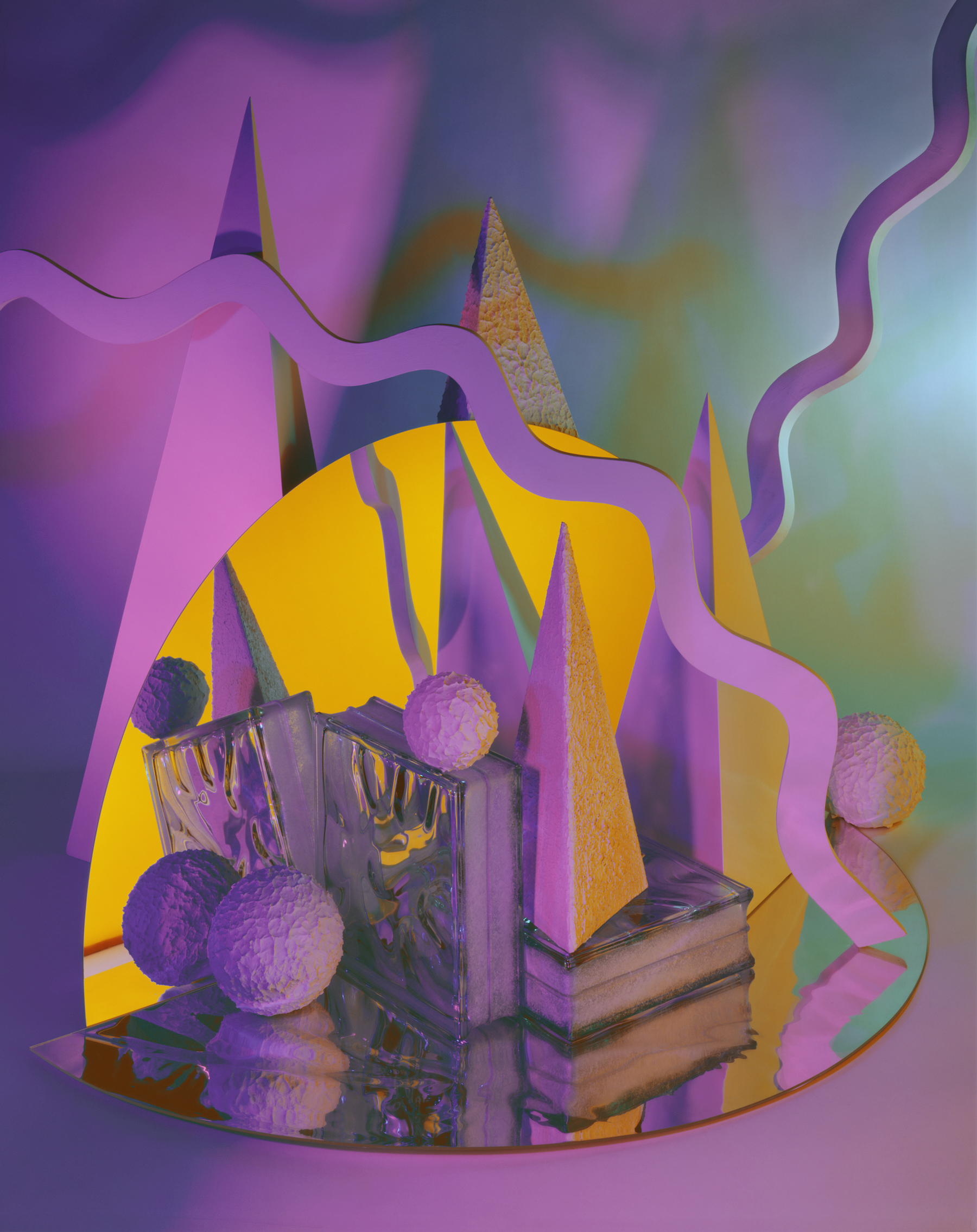
Barbara Kasten, Construct 32, 1986. Silver dye bleach print, 37 x 29 1/2 inches. Courtesy of the artist and Institute of Contemporary Art, Philadelphia.
Her work, as the recent exhibition Barbara Kasten: Stages shows, takes its strength from an exploration of the world beyond static or fixed images.1Photographs extend beyond pictures, beyond prints, to participate as facsimiles in tasks and exchanges. By recursively restaging the same elements—the textured sphere, the jagged pyramid, phantasmal Plexiglas, and mirror multiplying the tableau—they treat props like actors moving from scene to scene, “body doubles” for the presence and ghosting of the artist in action.2 Beyond the fact of depiction, Kasten’s images register responsive encounters with things, both in the tactile process of arranging her ensemble and through the analytic and distancing process of conferring with the camera. This performative and participatory staging exceeds the narrow definition they have received as formal prints, and their earlier critical dismissal as embodiments of commercial style. Neither simply materialist antecedents nor process resolved in formal language, Kasten’s works demonstrate studio-based production that far surpasses the rhetoric of final images.
Kasten trained as painter, fiber artist, sculptor, and photographer. She also worked as a window-dresser and stylist for department stores, and led art workshops in the United States Army on military bases throughout West Germany. As art historian Jenni Sorkin rightly points out in her essay for the exhibition catalog, Kasten’s early training in fiber and weaving translated into her later photographic work in important ways—procedural, conceptual, and iconographic.3 In her initial forays into photography, Kasten examined materiality through a focus on visible affect. Adopting nineteenth-century printing techniques—such as blue cyanotypes, brown Van Dyke prints, and hand-painted prints—she enacted a study of material translation rather than indexical reproduction. In the cameraless cyanotype photogram Photogenic Painting, 74/1 (1974), a mesh screen directly folded over and over on a photosensitive surface and exposed light creates warped moir. scales. Torso is a 1974 cyanotype in which a woman’s shoulders, back, and buttocks are overlaid on white and blue ground with hand-painted rules approximating notebook paper. These and many other examples point to her interest in mimicry across physical situations, images, and media. They also address photography as a pliant tool demonstrating the art of process. Torso’s precedents in Figure/Chair, Kasten’s series of diazotypes on newspaper from 1973, show a common, though diverging, basis: grids overlain on Dadaist collage, resulting in the jarring wit of sexual bodies combined with inanimate objects and minimal grids. Even the photo-replicative process carries supplementary meaning. Diazotyping is the process used to create architectural blueprints. Unless specially treated, or consistently copied, they are incredibly impermanent, fading within days or months. The architecture of design meets the lived experience of bodies, bodies turn objects (as props) into palpable, unwitting actors, all balanced on the cusp of humor and tragedy.
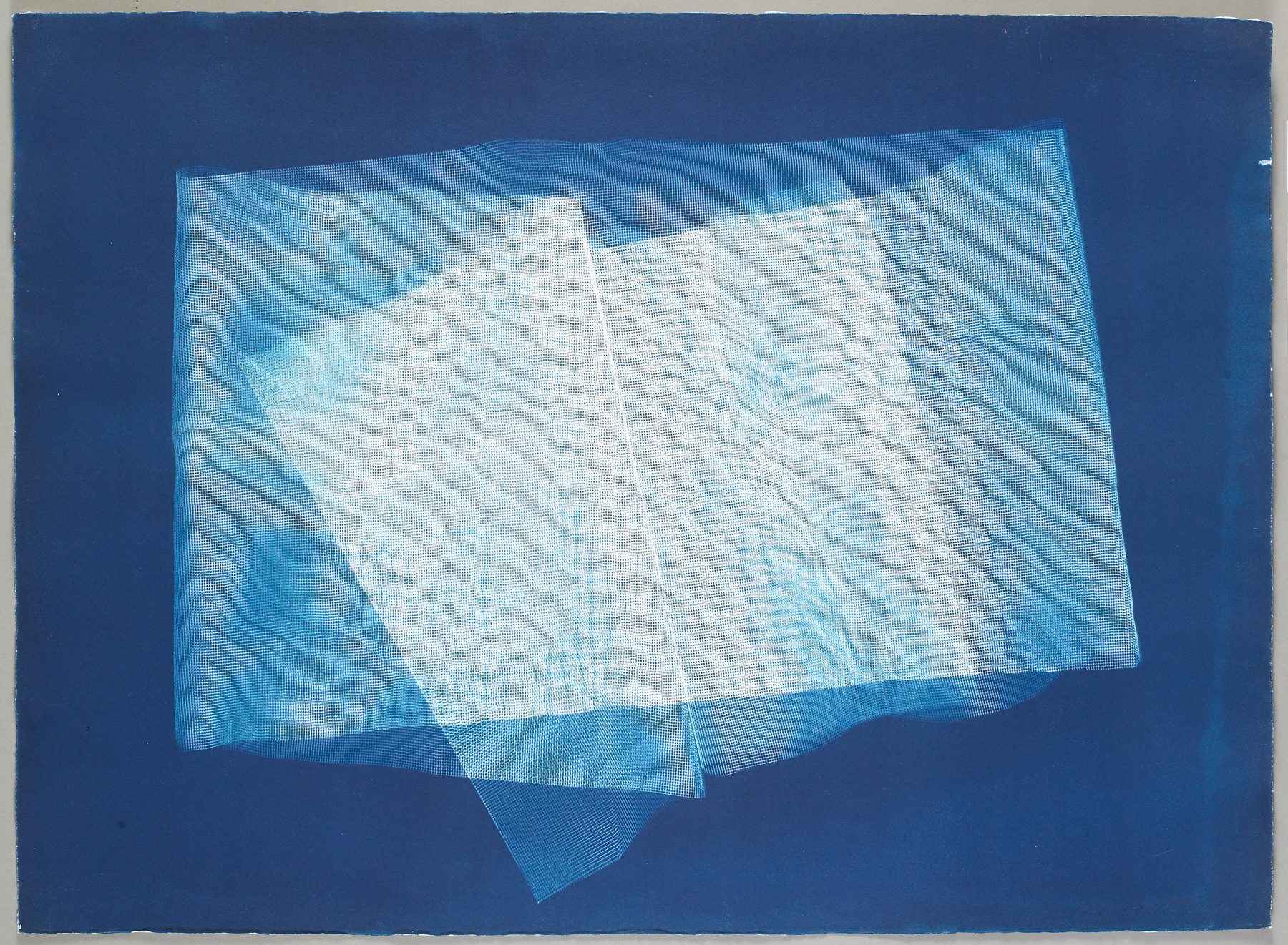
Barbara Kasten, Photogenic Painting, 74/1, 1974. Cyanotype photogram, 22 x 30 inches. Courtesy of the artist.
As the exhibition progressed in reverse chronology, older objects appeared as clarified, generative stages for Kasten’s oeuvre. Installed in the same gallery as the cyanotypes and diazotypes, her 1972 Seated Form sculptures emerged as the radicle of her performative bent. The sole fiber pieces in the exhibition, these three girthy works consist of simple café chairs, painted yellow, red, and green, and enveloped by matching handwoven and dyed sisal that overtakes each wooden structure with vulval folds and sags. Addressing the grid through their warp and weft, the pleasure of lush color and its gradients are expressed through texture and technique of craft. The red textile is a short-sleeved smock, usurping and transforming the chair into a satyr-like form: woven torso, spindly wooden legs. In the yellow sculpture, a torso-trunk sits on the frame, with an indented hole in place of an upper body and head. The green is the most straightforward, an inverted vaginal canal that drapes down and through the chair’s rim to replace the seat with abstract anatomy. The chairs were installed on a low, raised plinth, like a stage, and the prints installed in proximity are like concepts, charts and studies leading to a performance the viewer waits to see consummated in the sculptures’ corporeal theatrics.
Such works demonstrate a genealogy of production—engagements with material, sculpture, prop, and picture feeding one another within and beyond the picture frame. As Sorkin points out in her essay, this methodical triple basis in method, abstraction, and craft guides an understanding of Kasten’s work as not just performative. While it could be seen as spectacle, her vivid style has a more complicated agenda as disclosed technique. The prints are in a sense both pedagogical and potential. Manipulating the three-dimensional into a legible two, the photographs shift between flat and dimensional, material and optical, all within the same frame.4 Seated Forms and Torso are facsimiles of one another, encapsulating a complex feedback of action and optics. They turn away from mere reproductions of one another to embrace mediation as a concept articulated through material and form.
In her staging and set-work—as seen most prominently in the exhibition’s video documentation of Inside Outside (Stages of Light), a 1985 collaboration with choreographer Margaret Jenkins performed at the Brooklyn Academy of Music—the props that populate set after set concatenate and grow. Rather than limiting possibilities, the reusable components of the tableaux open the photograph beyond the frame, into a combinatory image-network of present, past, and future provocations. Both print and practice pivot, quietly, on the tell, on the staging, objects constantly reabsorbed from autonomy to tableau, original to facsimile and back again. Klein says it perhaps best: “Ever the ‘Constructivist,’ Kasten instead transformed the ‘picture’ into both a site of artistic production and a production in the theatrical sense,” making useless objects—blanks—“appear as if they could be used for something. … [For Kasten,] the prop, like the photograph, operates as both a proposal and a proposition, its usefulness equally tied to its mobilization as to its materiality.”5
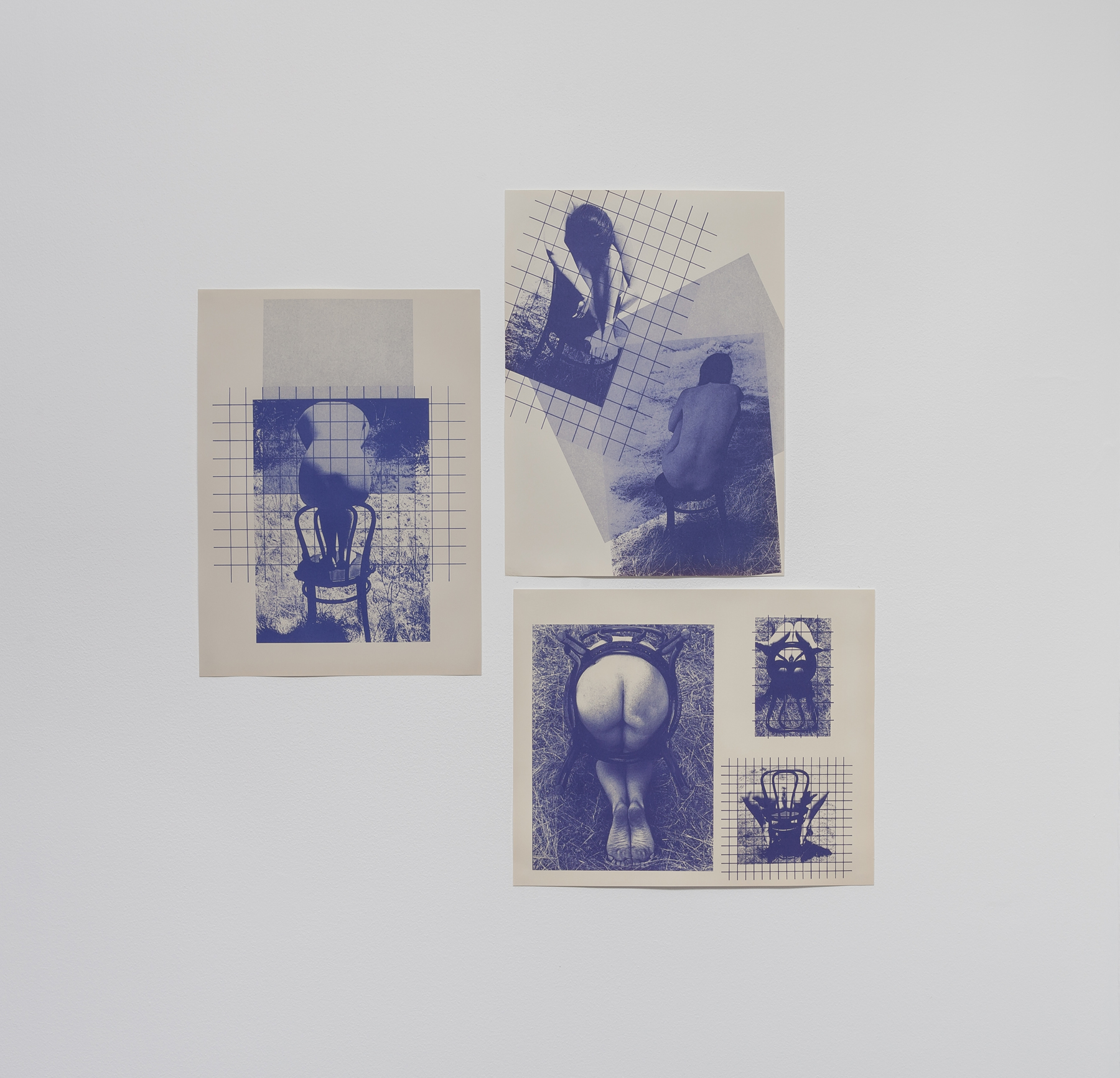
Barbara Kasten, Figure/Chair, 1973. Three diazotypes on newsprint. Graham Foundation, Chicago, 2015. Photo: RCH | EKH.
Kasten’s best-known works, and the focus of this exhibition, are the large-format photographs staged first in Constructivist then in wildly Postmodernist studio vernaculars. Starting in the late 1970s, she assembled her regular cast of inanimate actors—wavy fiberglass, the spheres and pyramids (blanks sourced from architectural supply stores), Plexiglas, and mirrors. The first photographs were black-and-white silver gelatin prints. In short order, however, Kasten began using colored gels and strobes deployed at different intervals within the same exposure.6 She created the colored works in tandem with operators at the Polaroid Company in Cambridge, Massachusetts, which, through its Artists Support Program (c. 1960–2008), delivered materials and equipment to artists in exchange both for technical feedback and works for their corporate collection.7 The images themselves became constructs, their subjects theatrically lit and installed, movement and change guiding their freeze-frame production into a whir of performance in suspension. She placed and replaced her objects as if choreographing parts in a fragile sculpture, holding each together with wire and rod, responding to the space of the setup, the architecture of the room, and the saturated shafts of light.8
Where Kasten’s photographs are her own “selective vision” of the sculptures she built, their installation enters the theatrical world of multiplicity and feedback, a mediation of front and back ends demonstrating the structural basis for the performance of self. This was especially apparent in the exhibition’s staging at the Graham Foundation in Chicago. Installed in the foundation’s 1902 Madlener House, a cubic, neoclassical building whose rooms are edged with rich decorative woodwork, the works took on a different surrogacy, echoing windows and doors, replacing the reflexive expectation of personal taste with a different kind of familial display: sculptures on the ground, their stilled lives hanging on surrounding walls. A top-floor ballroom played host to Scenario (2015), a 12-by-18-by-9-foot wedge-shaped diorama of four diminishing plaster cubes and a prism. A carefully sequenced video projection of colored geometric forms constantly transformed and shifted the objects between plastic and optical form, and from complex cityscape to backstage leftovers. Playing out in rotation, the video-sculptures staged pageants on old parquet, light and space and color and object in limitless concatenations, geometries constantly shifting, available for momentary capture from the unique position of a viewer seeing the tableau as image.
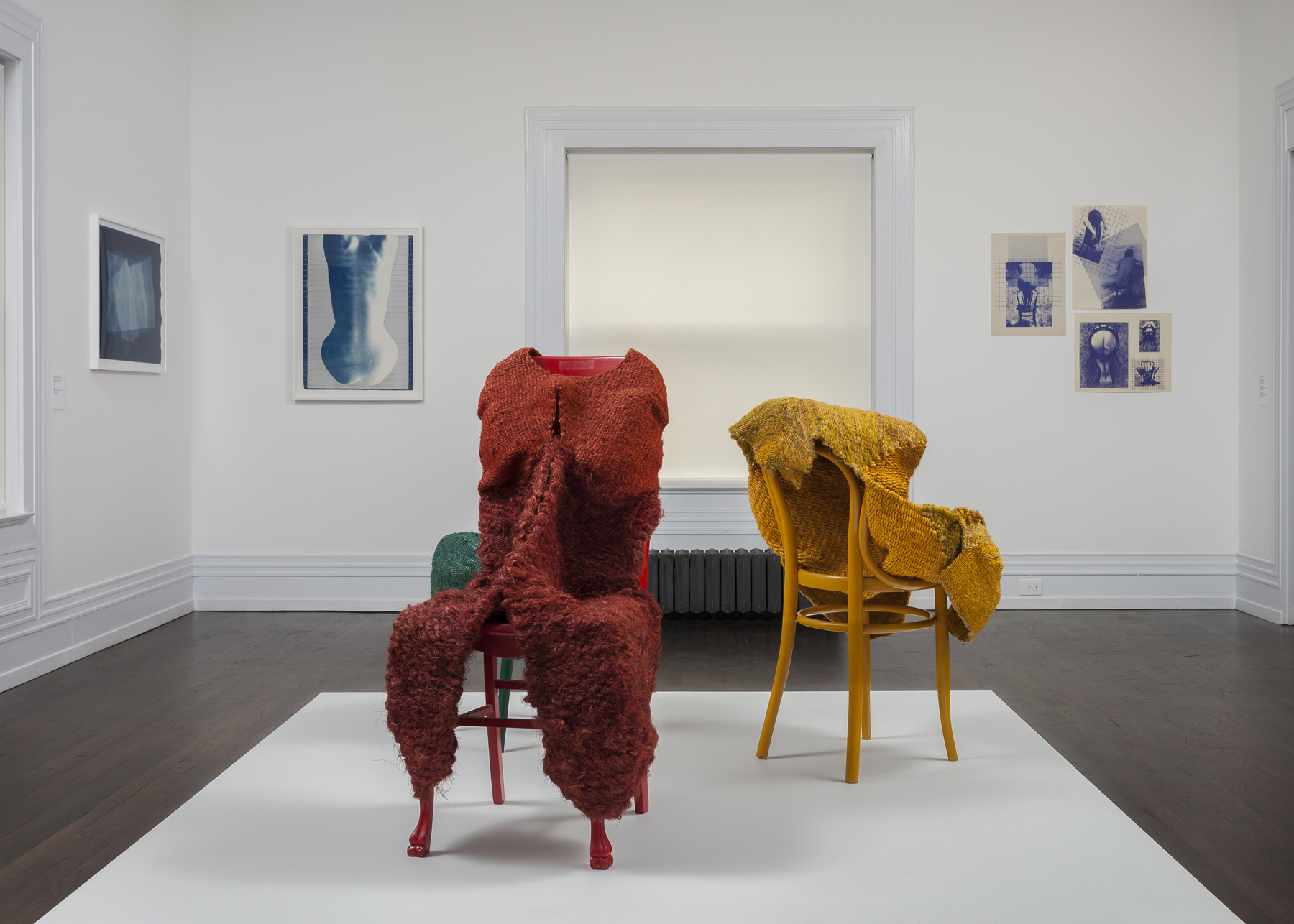
Barbara Kasten: Stages, 2015. Installation view, Graham Foundation, Chicago, October 1-January 9 2016. On wall: Photogenic Painting 74/1, 1974, and Figure/Chair, 1973; in foreground Seated Forms, 1972. Photo: RCH | EKH.
Kasten’s sensitive engagement with architecture as site and source resonates in her photographic prints, of course. The 1980s series Architectural Sites mingled with the corporate architecture of the 1980s, its savings and loan crises and freewheeling arbitrage measured in cool shapes and slick surfaces, ornamented with art tending toward the graphic. The wonderful thing about them, however, is the way they sidestep crassness to portray a cultural moment on its own visual terms: disco on cocaine and the relentless hyperspace of the mind captured as institutions, including museums. Kasten pictured more than a few museums, including Los Angeles’ Museum of Contemporary Art. A favorite is Architectural Site 17, August 29, 1988 (1988), showing the frozen interior of Richard Meier’s High Museum of Art in Atlanta. Each surface is a smooth panel of acid light on iced walls, spliced jagged like glass; the worried, listening face of Randolph Rogers’s 1859 marble sculpture Nydia is piped into the architect’s equally white geometry through a mirror’s retrospective reflection.
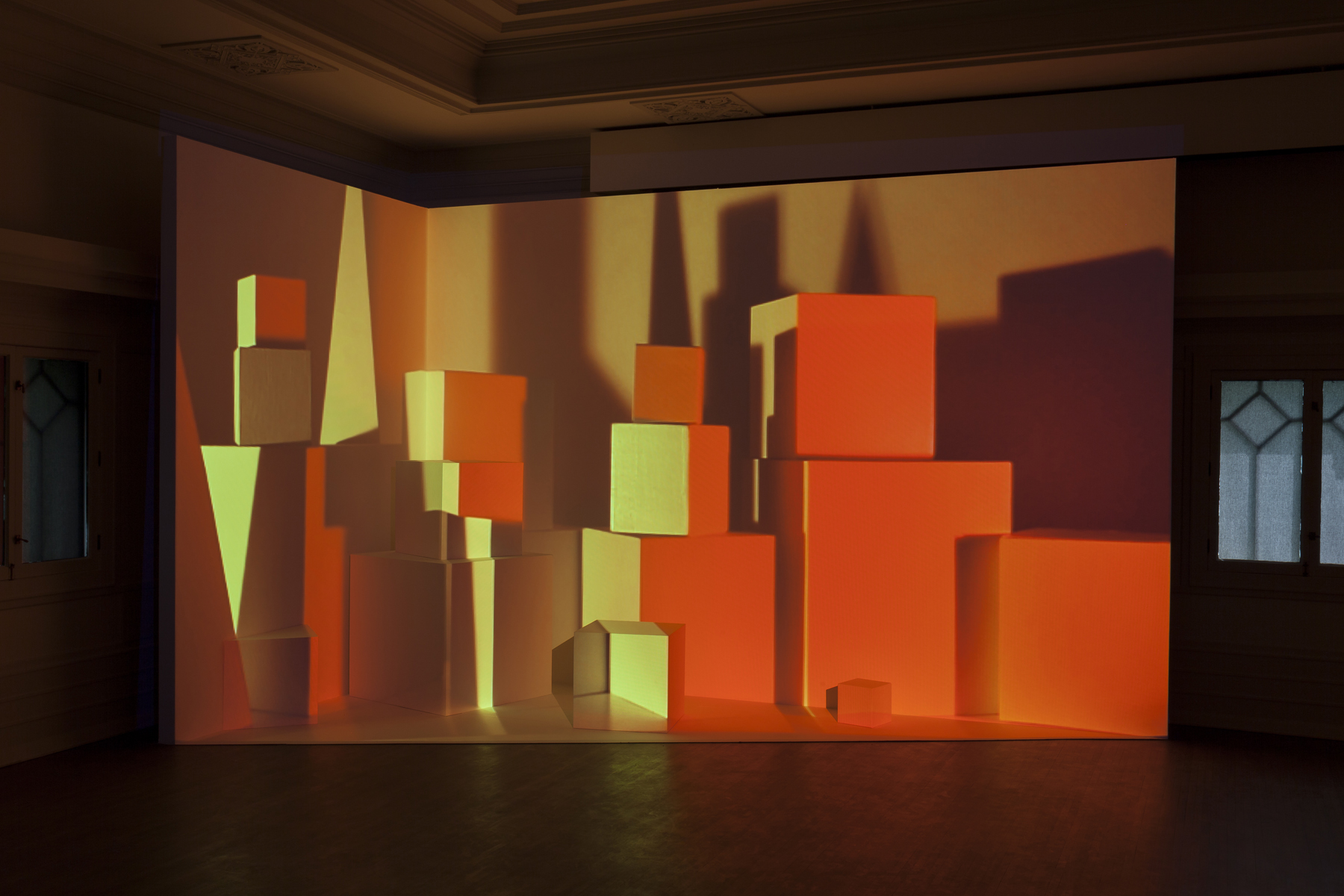
Barbara Kasten, Scenario, 2015. HD color video with plaster geometric forms, 12 x 18 x 9 feet. Installation view, Graham Foundation, Chicago, 2015. Photo: RCH | EKH.
The choice of Nydia for this work—witting or unwitting—encompasses many strands of Kasten’s oeuvre, taking it beyond visual comparison to populism and reference—design, Postmodern architecture, and advertising.9 Rogers’s original sculpture, which itself was copied and widely distributed, functions as an allegory; its main character is a blind citizen of ancient Pompeii trying to escape from the city’s ruin following the eruption of Vesuvius. Pompeii, of course, remained hidden half-intact, its bodies and homes held in stasis, preserved and suffocated under ash. In the 1850s and 1860s, the site was stabilized as an archaeological dig, and became a popular stop on the Grand Tour.10 Pompeii was the ultimate template for action in suspense, stories unconsummated. Throughout the early nineteenth-century, its excavators even found murals intact on the walls, providing classicists evidence of a riot of color, narrative, and ritual where minimal white had been presumed.

Barbara Kasten and Margaret Jenkins, Inside/Outside: Stages of Light, 1985. Still from video documentation of performance at the Brooklyn Academy of Music, New York, NY. Choreography: Margaret Jenkins; dancers/collaborators: Melissa Rolnick, Mercy Sidbury, Livia Blankman, Ellie Klopp, Bryan Chalfant, and Greg Gribble; costumes and set design: Barbara Kasten; lighting: Sara Linnie Slocum with Barbara Kasten; sound score and design: Bill Fontana; videography: Mark Robison. Courtesy of the artists.
I bring this up because of the complex of allegory, citation, and theatrics the case of Nydia entails. Nydia was a fictional character, imagined in text to animate a lost possibility, just as archaeologists generated plaster casts of preserved body cavities to propose a corporeal drama of pre-Vesuvian life. She debuted in Last Days of Pompeii, a novel written in 1834, just as Pompeii became the most popular story for live theatrical productions, and quickly valued for its bending of classics and fine art into entertainment.11 Most often, such productions were staged as tableaux vivants, with actors posing in a sequence of fixed stances orchestrated around props and lines spoken by an orator. The tableaux were preserved in photographs—another example of the image, like the prop, like the ruin, like the hyperspace of feinted allusion, mobilized into material record.12 It is probable that Randolph Rogers, the sculptor, first considered his subject matter from one or more of these forms—the novel, the staged production, or the photographic tableau. In each case, Nydia, like Kasten’s photographs, overcomes the classical division between the still perfection and the subordinate genre of movement. In both, the image becomes a transitional form, its use like a conduit between play and fact, a facsimile of life and its re-telling.13

Barbara Kasten, Architectural Site 17, August 29, 1988, 1988. Cibachrome, 50 x 60 inches. Location: High Museum of Art, Atlanta, GA; architect: Richard Meier. Courtesy of the artist.
What roles do props, as facsimiles, serve in Kasten’s work? How do they, or don’t they, enable a reading of photography as materially performative instead of merely documentary? One early address came via the art historian Erwin Panofsky. Writing in 1930 about the prevalence of study photographs (rather than in-person viewing) in examining and theorizing works of art, he isolated a supra-photographic form: the facsimile.14 Not a copy, which is a replica fully indexing, and therefore obliterating, the original, art facsimiles communicate origins of intent in making. For him, they were objects whose material lives continue outside their moment of capture in translation. A key example was the photographic reproduction of sculpture, the predominant tool in scholarly research at the time. Not degraded by utility, facsimiles (as opposed to copies) did not simply diminish originals for circulation in reproducible media. Instead of expecting the facsimile to replace the original, Panofsky valued the facsimile in terms of the knowing distance it enabled the scholar to contemplate. He saw the facsimile as a critical and educative enterprise; the image communicates the original intent of the work of art while disinterested in communicating an experience of authenticity.
From passive container to generative communicator, the facsimile performs the transformation of originals not into copies, but into a new realm—of image. Its aim is to create a “good reproduction,” one that does not suspend disbelief, but rather conveys the intention of three-dimensional objects into the new world of reproductive optics. A facsimile, in other words, hinges on two things—the object, its intent communicated by its posing for capture, and its translation into a new medium—while being aware of the work photography does to express all three simultaneously.15 Think of the earlier example of Kasten’s diazotypes and cyanotypes: they venture beyond index into material mediation. Their transfer of matter is not, and cannot be, a replacement. Instead, they are artworks, mediators of objects, ideas, and states of being as they pass from the mind to the physical world, through image and back again.
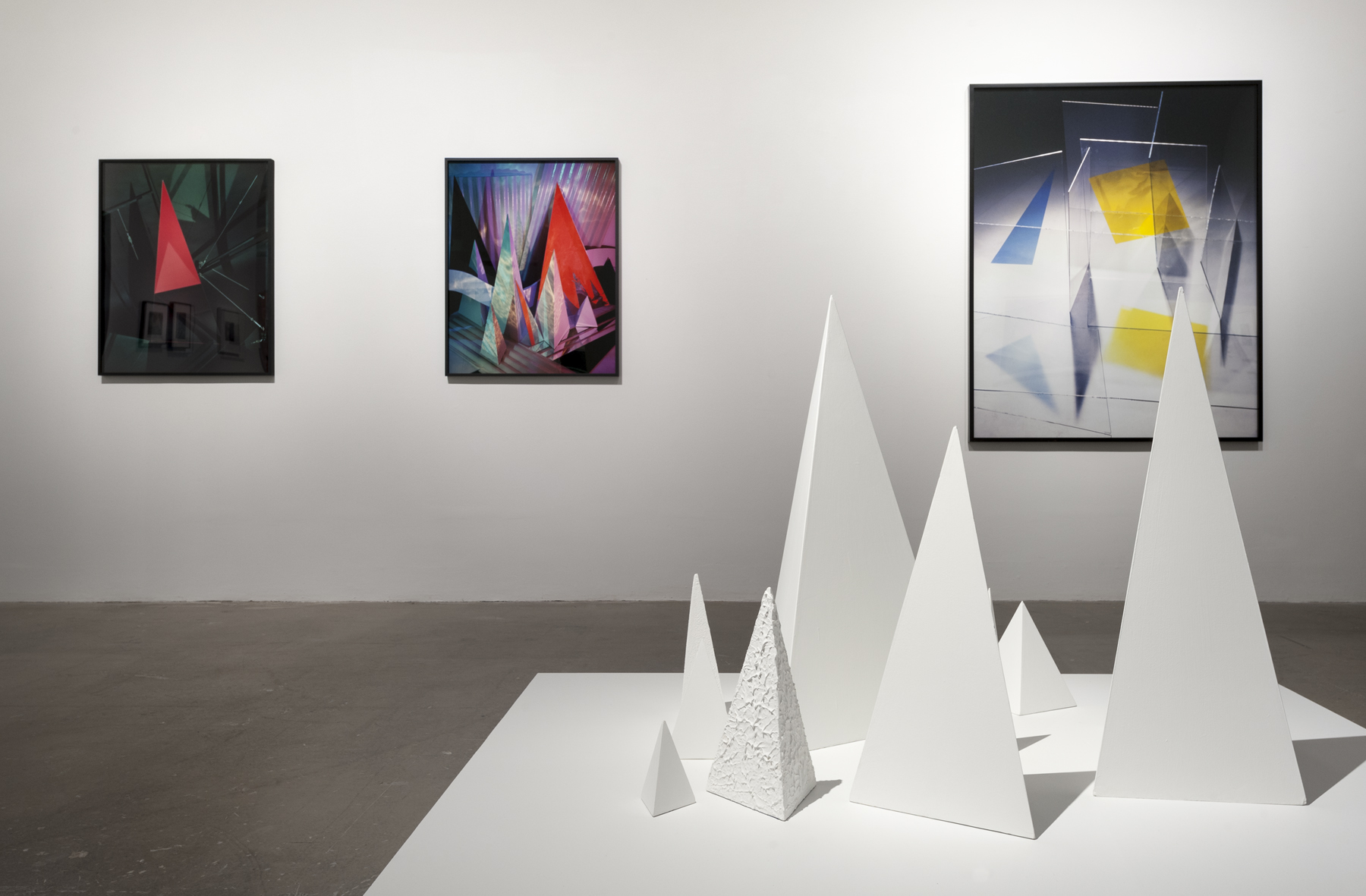
Barbara Kasten, Stages, 2015. Installation view, Institute of Contemporary Art, University of Philadelphia, February 4-August 16, 2015. Photo: Constance Mensh.
Another important thing to consider in reviewing Kasten’s art and architecture of performance is the physical context of display for the exhibition itself and the ways in which its installation across venues provides another kind of facsimile that manipulates an original into an edition.16 At the Institute of Contemporary Art, Philadelphia, the large institutional-industrial space of four galleries moved counter-clockwise, beginning with a grand space before breaking down into smaller arenas defined with half-height partitions. This allowed works ample space on flat white walls; colors burst from frames as if from the blank space of a computer screen, and works gathered in twos and threes in corners as if conversing in cliques. The division allowed curator and artist to explore the ideal space of geometry, its platonic shapes and converging lines, as itself a set-stage both for images and for many of the props found in Kasten’s works. The use of elements such as the rooms’ corners made phenomenal material of the architecture, and several totem-like light projections confounded depth, layer, and dimensionality.
Perhaps the most successful demonstrations of Kasten’s process and concern with context as material was Axis (2015), commissioned by the ICA and shown only in Philadelphia. The work consisted of panes of clear light shot into a convergence of walls; the composition shifted from squares to triangles and from cubes to pyramids at distinct purchases within the room. Hung next to Axis was Kasten’s 54-by-43-inch Scene VII (2012), a black-and-white configuration of Plexiglas and mesh transparently propping one another up, lit to cast a moir. pattern at the structure’s base and watery shadows of a window in film noir on the background; each prop, each piece, gains a second life, an extension through shadow that is difficult to trace back to a secure referent. The arrangement seems both supported by and supportive of the architecture of its staging, as if holding a wall upright. However, close inspection reveals the photograph’s ground as a sheet of backdrop paper, itself bearing two rips, like cracking wallpaper. The fissures sever the geometry with the precision and sentiment of realism—a tragic, insistent, specific reveal.
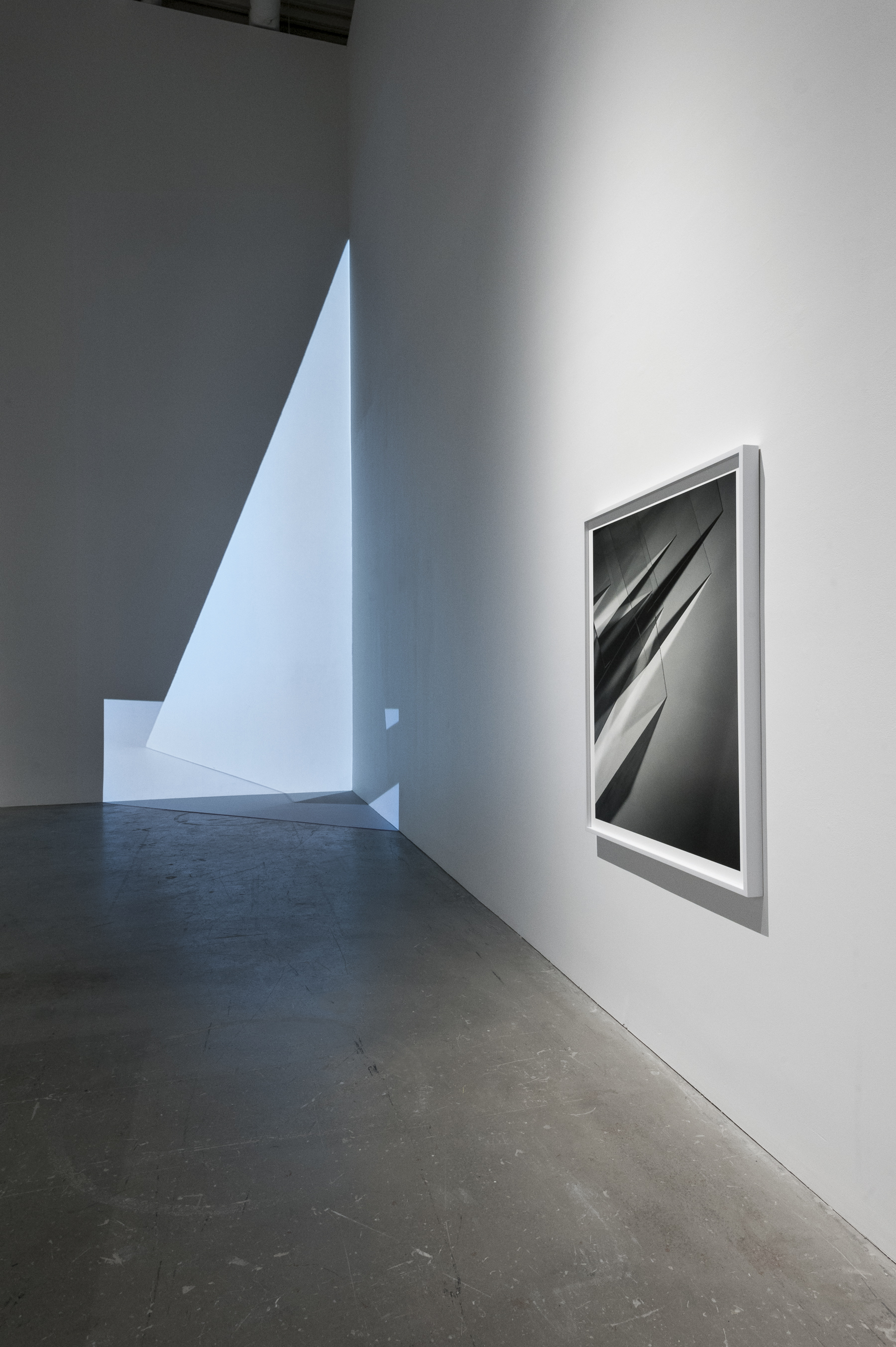
Barbara Kasten, Scene VII, 2012, archival pigment print, and Axis, 2015, video projection, installation view, Institute of Contemporary Art, University of Pennsylvania. Photo: Constance Mensh.
As ever, Kasten’s imaged space is delightfully indeterminate, both in print and in projection. However, whereas the projected works cursorily bring to mind the similar tropes of addition and reduction of Doug Wheeler and Robert Irwin, Kasten’s do more than release the body to its own infinite sublimity.17 Stages at ICA succeeded in expanding the scope of the image as proto-photographic—dismantling and recycling activities that include and surpass fixity and recasting the gallery as studio as a live set awaiting its participants. Stages developed institutional space as an active site of teaching and learning. As the artist remarked of her photographs in 2011, “The work was a construction that was made on site to be photographed. It also relates to the fact that an object is being photographed and yet part of the idea is to deconstruct that reality and make it an abstraction rather than the real thing.”18
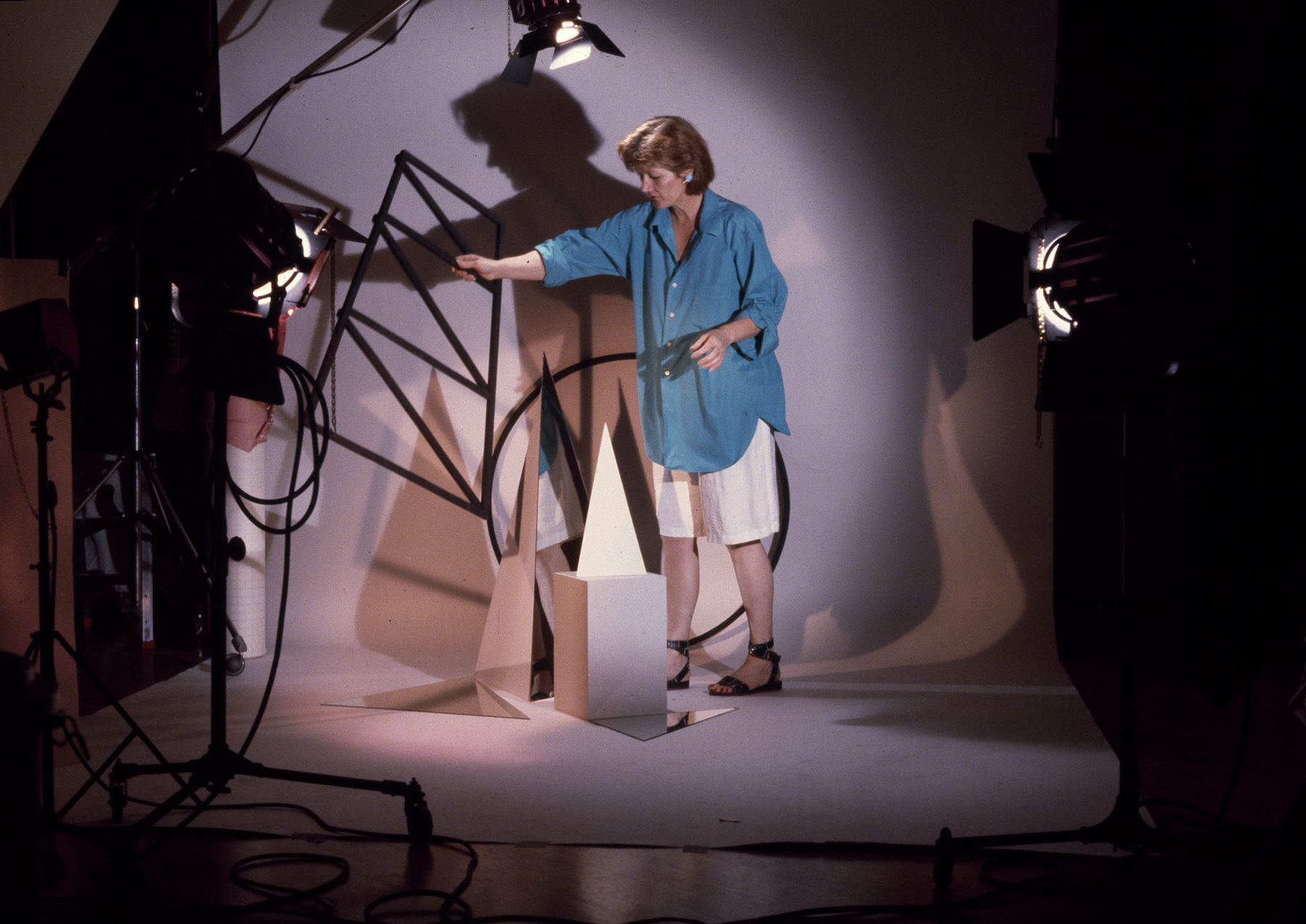
Barbara Kasten working in her studio, New York, NY, 1983. Photo: Kurt Kilgus. Courtesy of the artist.
Kasten’s statement and artworks stake the claim that materiality, and its awareness encoded in process, distinguish the weak copy from the strong work of art as a transformative operation. Nydia is valuable for the way she stands-in for historical fact as a placeholder, a symbol. Kasten’s Architectural Site 17, August 29, 1988 conflates sculpture and postmodern architecture through mirroring, skewering Meier’s cool rationalism with the campy color of stage lighting. Axis and Scene VII break stage and still into two acts: plays of light in actual space and plays of space in the light of images. None copies. Each recalculates, putting its makeover on display. Here again, we find an important resonance with Kasten’s work and its own preoccupation with material, procedures of making, and scaling up or down to human dimension. In human scale, the transformative communication of procedure and performance is to reinvest the work of art with the status of ritual: an enactment of social observance predicated around a set of confirmed rites. Her works are living pictures, unfolding moments of present activity that flow into and out of physical mediation.19 The tableau goes on, transmission materialized.
Susanna Newbury is Assistant Professor of Contemporary Art History, Theory, and Criticism at the University of Nevada, Las Vegas.
